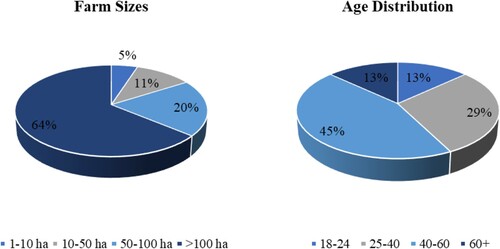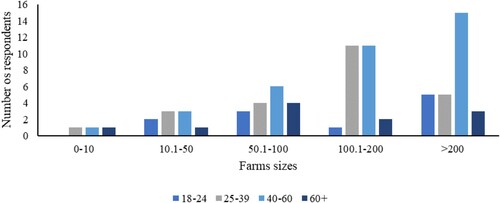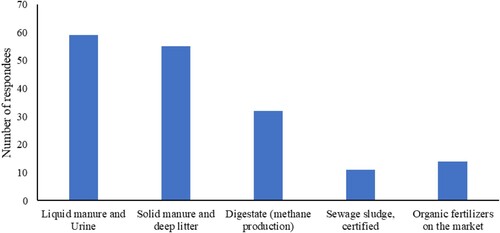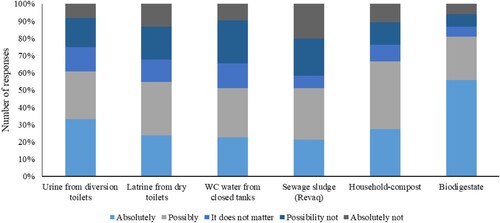ABSTRACT
Adequate treatment of organic manures and digestates from livestock production should reduce environmental impacts and provide well-defined and attractive biofertlisers for a crop production market, which can promote the closure of the nutrient cycle in agriculture. In this sense, a survey was conducted during the autumn of 2021 to investigate Swedish farmers’ perspectives on organic fertilisers use. The survey consisted of an online questionnaire, which was distributed broadly in the social media, homepages, different types of networks and at course events in order to reach all types of farms. There were 22 questions focused on current use, reasons for current use and preferences for future use. The analysis of the 99 fully responded surveys, demonstrated that 43% of the respondents think that they will increase their use of organic fertilisers in the coming 5–10 years and 60% think that they will use manure digestate in different forms (both solid and liquid fractions). Soil improvement was the main reason to use organic fertilisers, but there were also preferences for organic fertilisers with fast release of nutrients. The risk of soil compaction was the main reason not to use organic fertilisers and based on the responses, pellets and granulates seem to be more interesting than liquids and solids in general. Animal manures dominate the current use of organic fertilisers in Sweden however, other types of organic waste such as digestate and digestate derived fertilisers seems appealing to Swedish farmers. In conclusion, from this survey with 62% of the respondees in crop production, we found several indications of that there is a potential for increased use of organic fertilisers in Sweden on farms with limited use today. We found an openness, a broad interest and a demand for different types of products of different forms and origin. Since this demand in the end will almost always depend on the price of products in relation to the price of mineral fertilisers, which are fluctuating, we see the need of policy incentives in order to stimulate initiatives for the development towards increased circularity of nutrients.
Introduction
Traditional recognition of animal manures for their plant nutrition and soil improvement qualities has been challenged in recent decades due to the widespread availability of mineral fertilisers and the growing pressure to achieve higher crop yields. In 2018, the European Union (EU) countries consumed 11.8 Mt of nitrogen, 2.8 Mt of phosphates and 3.1 Mt of potassium, with a substantial portion being imported from third countries, posing potential risks to the EU's food security (Fertilizers Europe Citation2020). The energy-intensive production of mineral nitrogen fertilisers (Haber–Bosch process) and the limited phosphorus reserves, jeopardise the resilience of European agriculture and highlight the need for improved utilisation of alternative nutrient sources, aligning with the principles of the European circular economy concept (European Commission Citation2015; COM(Citation2012) Citation60 final).
The current linear flow of nutrients from mineral sources to food and animal products results in a concentration of nutrients in surplus agricultural outputs, which are not sold as products, particularly in animal manures (Tur-Cardona et al. Citation2018). Animal manures contain multiple macro- and micronutrients in both organic and inorganic forms, in a composition depending on the type of manure and manure management system. Application of organic fertilisers, like manure, to the soil will increase the soil organic matter content and increase soil’s plant nutrient availability, which are a key indicators of soil fertility (Cai et al. Citation2019; Gerke Citation2022). Nevertheless, the specialisation of the livestock sector has led to a disconnection between animal husbandry and crop production, treating manures as waste rather than valuable sources of nutrients and organic matter (Awasthi et al. Citation2019; Puech and Stark Citation2023). The concept of a circular economy embodies a system in which materials are perpetually reused, and the natural environment is rejuvenated. Within this framework, products and materials are retained within the system through various processes, including maintenance, reuse, refurbishment, remanufacture, recycling, and composting (Ellen McArthur Foundation Citation2023).
Closing the nutrient loop in the agricultural sector, including the proper management of animal manures and digestate, is important to reduce nutrient losses into the environment and provides renewable substitutes for mineral fertilisers (Scholtz Citation2017). Inadequate or excessive manure application can lead to environmental risks such as emissions to the atmosphere and soil discharges throughout the manure's lifecycle (Chadwick et al. Citation2011).
Despite multiple values of animal manures there are reasons why manure nutrient use efficiency in agriculture is lower than what is possible (Akram et al. Citation2019). One is the high water content and bulky properties which constrain both storage possibilities and transport distances. Typical dry matter contents vary from around 3% in pig and dairy liquid manures to 30% in solid manure (Hjorth et al. Citation2010; Christensen and Sommer Citation2013; Manitoba Government Citation2015). There will always be a trade-off between the fertiliser value of the manure and the cost for transport, especially for distribution between farms, which will cause surplus of nutrients on farms or in whole regions with high animal density (Svanbäck et al. Citation2019). On the other hand, the liquid manures often have a substantial N fertiliser value which may reach up to 90% compared to the respective agronomic value of mineral fertilisers, provided that measures are taken for reduced ammonia losses during storage and application (Sommer and Hutchings Citation2001; Birkmose Citation2009). The N fertiliser value of solid fraction during the first year after soil application is often lower, ranging between 25% and 50%, but promotes the soil N mineralisation in the long-term therefore, the risk of N losses (Jensen Citation2013; Ferreira et al. Citation2022). The uncertainty of the N fertiliser value and a relatively low N/P ratio of animal manures may decrease interest among conventional crop-producing farmers to purchase organic fertilisers (Tur-Cardona et al. Citation2018), and there will still often be a need to supply the crop with extra N from mineral fertilisers. At the same time there may be a surplus of P which may increase the risk of negative impact on water quality in the long-term (Zhang et al. Citation2021).
Europe produces 1350 Mt of manure each year, but its distribution is uneven, resulting in significant nutrient imbalances between countries and regions (Scarlat et al. Citation2018; Svanbäck et al. Citation2019). In areas with high livestock density, manure often accumulates on farms during winter months and is subsequently applied directly to nearby fields (Kleinman et al. Citation2015).
Despite the availability of various technologies and the evident need for organic waste management, in order to produce concentrated and valid fertilisers, less than 10% of manure produced in the EU has undergone treatment (Foged et al. Citation2011). From the countries surrounding the Baltic Sea, Germany and Denmark process approximately 14% of the produced manure, but others, including Sweden and Poland, have much lower rates of treatment (Foged et al. Citation2011).
In terms of environmental emissions, the livestock sector is a major contributor to inorganic phosphorus losses in inland and coastal waters, as well as emissions of ammonia (59%), methane (17%) and nitrous oxide (12%) (Eurostat Citation2013; Leip et al. Citation2015). Furthermore, water bodies can suffer from nutrient enrichment (mainly N and P), either through direct losses (runoff) or atmospheric depositions, leading to global warming, ecosystem acidification and water quality degradation (Montes et al. Citation2013; Rojas-Downing et al. Citation2017). The Baltic Sea is highly susceptible to the impacts of nutrient runoff, and the process of eutrophication in the Baltic Sea has been ongoing for several decades, combined with anoxic conditions, and harmful algal blooms (Swain Citation2017; WWF Citation2023).
Therefore, improved manure management and handling are crucial for increasing nutrient use efficiency and reducing nutrient losses to vulnerable regions such as the Baltic Sea (Brady et al. Citation2022). Environmental legislations at both European and national levels address manure management and soil application, with specific targets outlined in the Baltic Sea Action Plan adopted by countries surrounding the Baltic Sea, such as Sweden, Denmark and Finland (HELCOM Citation2021).
Studies have primarily focused on identifying barriers to the adoption and diffusion of manure treatment technologies, such as policy limitations, high investment and processing costs, and limited marketability of the products (Hou et al. Citation2018; Konrad et al. Citation2019). The interest in the utilisation of processed manure as fertiliser exists, however, crop producers may encounter difficulties in accessing such products. This issue arises when they are located at a considerable distance from animal farms or manure processing facilities, such as anaerobic digestion plants. In order to increase the distribution and the adoption of organic fertilisers, several factors need to be considered, including affordability, accessibility and compatibility with existing agricultural machinery (Case et al. Citation2017). To the best of our knowledge, only a limited number of studies have investigated these inquiries, leaving a significant knowledge gap regarding farmers’ willingness and preferences to utilise organic fertilisers. Therefore, assessing the attitudes of product users, particularly crop producers, is essential to drive policy changes and promote the adoption of manure-derived products within a circular nutrient usage (Barquet et al. Citation2020).
Hence, the objectives of the study are: (i) to investigate the current use of organic fertilisers and future willingness of farmers to adopt new organic fertilisers and (ii) identify key attributes of products that increase the interest of farmers.
Material and methods
The investigation of the current and future use of organic fertilisers in Sweden was conducted in the forms of a digital survey, available online between October 2021 and January 2022. Due restrictions to unsolicited address farmers which would allow the questionnaire to be based on a statistical sample, the farmers were reached randomly through online channels, advertisements in sector-specific newspapers and at meetings with farmers. The aim was to reach a diverse range of farmers, but not necessarily to get answers from a group representing the Swedish farmers in general. This approach opened up to attract farmers interested in organic fertilisers and explore the preferences they have. The survey focused on manure-derived fertilisers as the most abundant and agronomically interesting feedstock for biogas production but also contained questions about commercial organic fertilisers and human excreta as potentially interesting sources of nutrients.
The questionnaire was constituted of 22 questions, distributed in the following categories: (1) background information (location, production form, farm size, age and gender), (2) current use of organic fertilisers and amounts of N and P, (3) predictions for future use of organic fertilisers and preferences for types, formulas and amounts and (4) specific reasons to use or not to use organic fertilisers. The entire questionnaire is presented in Appendix 1. Before the implementation, the questions underwent a testing phase with farmers to ensure their effectiveness, and necessary adjustments were made based on the feedback received.
After the application period, the collected responses were compiled and organised. For the compilation of the results a minimum answer frequency of 80% for each question was required to be included in the presentation of results. The questions were thoroughly examined and compared to identify patterns and outliers within the data set. Additionally, the background information provided by the respondents was cross-referenced with the official statistical data from the Swedish Board of Agriculture (SBA), which is the authority responsible for monitoring and analysing the development within the agriculture sector and ensure that the food production in Sweden is sustainable and profitable. This comparison aimed to investigate the representativeness of the responses by assessing how well they aligned with the average conditions prevalent in Sweden.
Results
Composition of the farms
According to the SBA, the total number of farms in Sweden was 58,791 as of 2020 (Jordbruksverket Citation2020). In total, 345 respondents have accessed the questionnaire but only 29% of the farmers answered more than 80% of the posed questions, which was set as the lower limit to include the individual questionnaires in the current analysis. The total of 99 farmers from various regions across almost the entirety of Sweden included in the current study represents approximately 0.2% of the total number of farms in the country and they were not entirely representative for the diversity of Swedish farmers. There are potential biases regarding the farms that responded to the survey, since they might be already using organic fertilisers, hence more interested and engaged, which was also expected. Similar approaches, either in regional- or cross national-scale, have been previously demonstrated sufficient to depict farmers attitudes (Tur-Cardona et al. Citation2018; Melo et al. Citation2019). Therefore, while the respondents’ number may only partially represent the diversity of Swedish farmers population, the results are deemed important to get an understanding of farmers’ preferences and willingness to accept organic fertilisers and broaden the discussion around the topic.
Most of the farms participating in the survey, 62% were primarily engaged in crop production and 38% in animal production. Most of the crop production farms were producing annual crops like cereals, legumes or oilseeds, and 5% were focused on ley production. The distribution among the livestock farms was 47% dairy, 33% beef, 8% pig, 6% poultry and 6% sheep.
Most crop-producing farms did not have secondary production activities, with only approximately 20% of them incorporating animals as part of their secondary production. Thus, the study had an expressive representation of crop producers, the consumers of organic fertilising products, which aligns with the objective of the study to address the attitudes and preferences of organic fertilising products end-users.
Farmers from both organic and conventional farms answered the survey, with the majority being conventional. In Sweden, conventional agriculture involves the use of synthetic crop protection chemicals and mineral fertilisers to support plant growth, while organic agriculture does not. Organic farmers must rely on organically derived fertilisers and also strive towards a high degree of self-sufficiency which often implies lower animal density on organic farms (Jordbruksverket Citation2023). Specifically, 77% of the respondents practiced conventional farming across all forms of production. Among livestock producers, around 70% followed conventional production methods. Similarly, most crop producers adhered to conventional practices, with only 18% of them being organic.
shows that a significant portion of the participating farmers, 64%, operated large farms, particularly in the range of 100–200 ha and over 200 ha. Conversely, the number of farmers decreased as the farm size decreased below 100 ha. Only 5% of the farmers reported having between 1 and 10 ha of land.
Regarding the age demographics, it is presented also in that most surveyed farmers fell within the age range of 35–60 years old, while the majority of Swedish farmers were between 50 and 64 years old according to SBA (Jordbruksverket Citation2021).
In order to gain a more comprehensive understanding of the farm composition, the age groups of the participants were compared to the size of their farms, as shown in . This analysis revealed that it was more common to have large farms (>200 ha) for the farmers in the 40–60 years age range while the oldest age group predominantly had farms in size of 50–100 ha.
Current use of organic fertilisers
In this survey, a significant majority of respondents, approximately 80%, reported that they use organic fertilisers. This implies that also crop producers (62% of the respondees), without livestock, use organic fertilisers. To what extent they use manure from livestock farms or organic fertilisers on the market was not explicitly evaluated, but the distribution of the use of organic fertilisers indicates that many crop utilised animal-based manure, both in liquid and solid forms, as shown in . The use of organic fertilisers was dominated by animal manure in liquid and solid forms, 66% and 70% of the respondees, respectively. As for digestate from methane production, it was used by 13% of the respondees.
The questionnaire also asked for other type of organic fertilisers and processed fractions of manure and digestate, which showed to constitute minor usage among the responding farmers; composted manure or digestate (6%), pelleted manure or digestate (4%), acidified liquid manure or digestate (0%), separated liquid fraction of manure or digestate, (4%), separated solid fraction of liquid manure or digestate (0%), biochar (1%), source separated closet water (0%), urine from diversion toilets (1%) and others (4%).
Furthermore, the survey findings indicate that although many farmers utilised organic fertilisers, only a limited number were able to fulfil their nutrient requirements solely through the application of organic fertilisers.
Applications of fertilisers on farms
The survey asked for how much N and P that farmers applied in total per hectare and how much was specifically applied with organic fertilisers. The given figures for organic fertilisers contain uncertainties. There is probably a wide span between rough estimations of N and P content in utilised manures and reliable figures for farms where N and P content was analysed. Moreover, respondents may have reported either total or estimated plant available content in applied manure, which would affect the results, and some farmers also indicated that they did not know the amounts used.
Nevertheless, (line) shows that approximately half of the farms applied between 101 and 170 kg N/ha in total, which aligns with current legislation and in well accordance with the recommended amounts for spring cereals and winter wheat. However, the rates of N with organic fertilisers were considerably lower on most farms. For example, for farms applying between 136 and 170 kg N in total organic fertilisers constituted at maximum 65 kg/ha on 95% of the farms (, bars) This indicated that mineral N applications were important for crops with high N demand, and that many farms used quite small amounts of organic fertiliser in total as also shown for P in .
Figure 4. Amount of applied N presented for intervals of N amounts applied (kg per hectare). The line shows the distribution among respondees (%) for applications of total amounts of N (organic and mineral). The stacked bars show how much of N applied (kg per hectare) came from organic fertilisers, presented as distribution among respondees within each interval on x-axis.
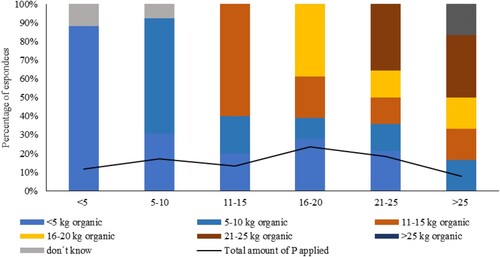
Figure 5. Amount of applied P presented for intervals of P amounts applied (kg per hectare). The line shows the distribution among respondees (%) for applications of total amounts of P (organic and mineral). The stacked bars show how much of P applied (kg per hectare) came from organic fertilisers, presented as distribution among respondees within each interval on x-axis.
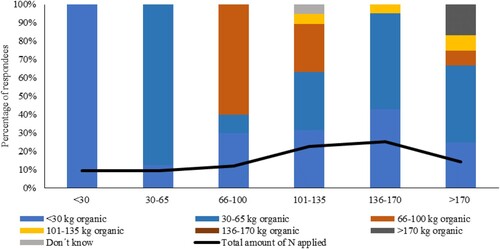
For P, the distribution among different application intervals were even larger than for N, but only about 10% of the farmers applied less than 5 kg or more 25 kg/ha (, line). However, it is important to note that not all farms within this category reported the exact amount of P applied in organic form, as some respondents indicated a lack of knowledge regarding their organic P application practices as was also true for N. Similar to N, the majority of farms applied P within higher ranges (16–25 kg/ha). For farms applying low amounts of P, indicates that the need of P was almost entirely covered with organic fertilisers.
Future use of organic fertilisers
To measure farmers’ attitudes toward adopting new types of organic fertilisers, they were asked about their potential use of different fertilisers over the next five years. The results, presented in , revealed that the organic fertilisers most favoured for future use were animal slurry and solid manure, which also happened to be the most commonly ones used at present. On the other hand, those were the types more likely to reduce the usage to future, leaving room to other alternatives, such as organic fertilisers on the market (e.g. biofer/ekoväxt) and certified sewage sludge (REVAQ).
Table 1. Current vs. anticipated future use of organic fertilisers according to the farmers’ perceptions in the perspective of the coming five years (number of answers).
By subtracting the current use from the anticipated future use, it was possible to identify organic fertilisers with the highest potential for increased adoption. According to the comparison, 20 individuals expressed their willingness to use digestate from methane production in the future, indicating that they were not currently using digestate but might consider doing so.
Furthermore, the solid and liquid fractions of separated animal slurry or digestate emerged as organic fertilisers that several individuals may consider utilising in the future, despite only used to a limited extent or not at all today. Presently, only three people reported using the liquid fraction and none reported using the solid fraction of separated slurries, but 15 consider testing them if available in future. Other organic fertilisers that showed potential for increased future usage included composted animal manure or digestate and source separated sewage fraction. Conversely, organic fertilisers such as animal slurry and solid manure/deep litter were unlikely to see increased usage compared to the current levels, which is a natural consequence if a larger proportion will be processed into other products such as digestate. These two organic fertilisers remained the most used options also for future anticipated use and reflects that the farmers will continue with livestock production as today.
In terms of the amount of organic fertilisers to be used in the future, most farmers who participated in the survey indicated that they either planned to maintain the same level of use (50%) or increase their utilisation of organic fertilisers in the future (44%). Only a small proportion, approximately 6%, estimated a reduction in their use of organic fertilisers.
Properties of the future organic fertilisers
In the survey, farmers were asked to rank their reasons for choosing to use organic fertilisers and to identify the main obstacles they faced in using them. The questionnaire provided potential reasons for using organic fertilisers, including soil improvement, price, environmental considerations and fertiliser value and the responders were asked to rate them (most important, quite important, less important but still relevant). In , the answers are presented without ranking, with each response being weighted equally based on the frequency of selection across all three levels.
Figure 6. Reasons and level of importance for using organic fertilisers, according to the respondents.
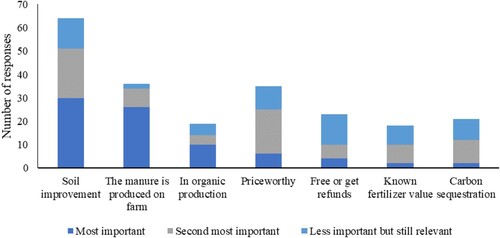
The results showed that the most important reason for using organic fertilisers was their soil improving properties, as the second highest was the availability of manure due to the presence of livestock on the farm. Overall, it is important to note that not all alternatives were ranked, which means that the aspect is not even relevant and potentially led to low ‘less important but still relevant’ answers.
When it came to reasons not to use organic fertilisers, the highest ranking reason is that it contributes to soil compaction. This issue arises due to fact that for example wet manure and digestate have high water contents and thus low nutrient concentrations per kilogram of wet weight. To achieve the desired application rate, a large and heavy tank or multiple passes with a smaller tank may be required, which can increase the risk of soil compaction. This shows that the main reason for either using or not using organic fertilisers are connected to the effects on the soil.
The second highest ranking reason for not using organic fertilisers was the perceived expense associated with their application. Farmers expressed concerns about the cost involved in spreading organic fertilisers. The third highest ranking reason was the uncertainty regarding the nutrient content of organic fertilisers. Lastly, the fourth-ranked reason for not using organic fertilisers was the difficulty in accessing them, particularly for farmers who no longer have animals to provide a source of organic matter.
As for the factors that ranked lowest as reasons for not using organic fertilisers, shown in , were their perceived expense and the potential environmental impact they may have. These factors were considerably less influential compared to the concerns related to soil compaction, cost of spreading, uncertainty in nutrient content and availability without livestock.
Figure 7. Reasons and level of importance for not using organic fertilisers, according to the respondents.
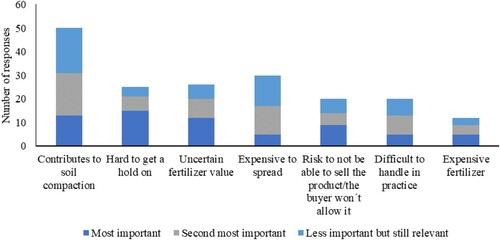
Nutrient release and carbon content
Farmers participating in the survey were also asked about their preference for a quick or slow release of N and P in organic fertilisers. Most of the farmers answered that they preferred fast release of N (65%) and of P (53%). However, a substantial part clearly preferred slow release of nutrients, for P almost half of the respondees.
To gain further insights, the question about N and P release was analysed in relation to whether the responding farmers practiced conventional or organic farming. The comparison revealed that there were some differences between conventional and organic farms, where a larger proportion organic farmers were interested in slow release fertilisers, especially for P, as shown in .
Figure 8. Preference between slow and fast release of nutrients, according to the respondents (percentage of answers) divided into answers from farmers practicing organic and conventional farming, respectively.
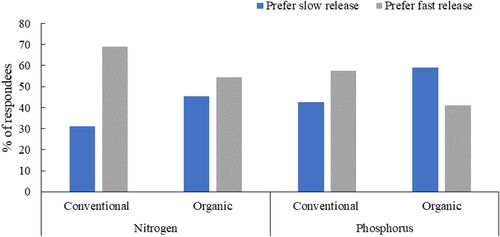
Similar to the comparison made for nutrient release preferences, a comparison of conventional and organic farmers was made about the importance of C content in organic fertilisers, as presented in . A higher proportion of conventional farmers regarded C content as important and quite important compared to organic farmers, while a greater percentage of organic farmers responded that C content was not important in organic fertilisers compared to conventional farmers.
Table 2. Importance of carbon content in organic fertilisers, according to the respondents in % of total and distributed on conventional and organic farms.
Preferred form
There was also a question in the survey about preferred form of future organic fertiliser. The survey revealed that granulates were the most favoured forms, followed by pellets and liquid fertilisers. The combined solid and liquid forms were more preferred than the semisolid forms, but they were not as popular as granules, pellets and liquid fertilisers, as seen in .
Interestingly, there was no discernible pattern of preference based on the farms’ current use of organic fertilisers. For instance, farmers who currently used liquid manure exhibited the same level of optimism towards pellets as farmers who used digestate or composted manure. This suggests that the farmers’ preferences for future organic fertilisers were not significantly influenced by their current utilization of specific forms of organic fertilisers.
Alternative organic fertilisers
To assess farmers’ receptiveness to alternative organic fertilisers derived from human waste streams, the participants were asked to indicate their level of consideration for using these types of fertilisers in the future. The survey included various options of alternative organic fertilisers, and respondents were asked to choose from response options: ‘absolutely’, ‘possibly’, ‘rather not’ ‘absolutely not’ or ‘it does not matter’. The alternative organic fertilisers presented in the survey included urine from urine separating toilets, litter from a dry toilet, water closet (WC), water from closed tanks (excluding greywater), certified sludge (REVAQ), household compost and digestate. The participants’ responses provide insights into their willingness to explore and adopt these alternative organic fertilisers in their farming practices, which can be seen in .
The results indicated that many farmers expressed optimism about using alternative organic fertilisers, with most responses falling under the categories ‘absolutely’ or ‘possibly’, which represent high priority. Among the alternative organic fertilisers, digestate emerged as the most popular choice among the participants. It was followed by urine from urine separating toilets and household compost, which were the second most preferred options. However, farmers appeared more sceptical, with almost 50% less respondents indicating that they would ‘absolutely’ use urine compared to the respective attitude towards the use of digestate ().
This, there was not a significant difference in the number of participants who could ‘absolutely’ consider using sewage sludge compared to urine. This suggests that these two alternative organic sources were relatively comparable in terms of their acceptance among the surveyed farmers. Overall, except for digestate, the survey results indicated that there was relatively similar and moderate receptiveness among farmers towards considering various alternative organic fertilisers as potential options for their farming practices, both for separated fractions of latrine, sewage sludge and compost.
Furthermore, a comparative analysis was conducted to assess the relationship between age and the inclination towards alternative organic fertilisers, which is presented in .
Figure 11. Distribution of positive versus negative inclination towards alternative organic fertilisers according to the age groups of the respondents.
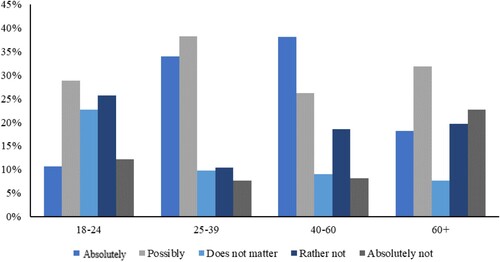
The survey data revealed notable variations in responses across different age groups. The older participants exhibited the most cautious approach with the highest ‘absolutely not’ answers. Meanwhile, most younger participants indicated a possibility of using alternative organic fertilisers rather than expressing absolute enthusiasm. In contrast, the age group of 25–39 displayed a higher level of optimism, with a significant portion stating their absolute willingness to consider alternative organic fertilisers. The age group of 40–60 exhibited the highest level of absolute positivity towards organic fertilisers similar to the 25–39 age group that were considerable positive as well.
Discussion
With the approach with open distribution of the survey probably individuals who were more receptive to use current and new organic fertilisers than the average farmer was motivated to participate. Therefore, the survey results should be interpreted, considering the potential bias towards farmers who were already interested in exploring alternative organic fertilisers, which is not necessarily negative for the aim of the study which was to identify key attributes of products that increase the interest of farmers. The cautious approach among older participants regarding alternative organic fertilisers, presented in , may reinforce the theory of self-selection bias in the survey results, as there were few respondents over the age of 60, but not fewer than the youngest group, as shown in . This suggests that the survey may primarily reflect the preferences of a specific group of farmers already interested in such fertilisers.
Even though no statistical method was used for sampling of the respondents, it is still important to connect our results to the statistics available in Sweden to attempt to find some parallels and points of validation. The survey results revealed a higher number of crop-producing farms (62%) compared to the figures reported in the Swedish statistics for 2020, where 28% of Swedish farms were reported as crop production farms, 34% as mixed or animal farms and 38% too small to be identified (Jordbruksverket Citation2020).
On the other hand, the distribution between organic and conventional production (23% and 77%, respectively) in the survey aligns with the proportions reported for Sweden, in 2020, when 19% of arable land was under organic production (Jordbruksverket Citation2020). Regarding specific product categories, most of the beef and dairy products, approximately 85% of the farms with livestock, were conventional, slightly higher than the corresponding percentage in the survey (70%) (Jordbruksverket Citation2021).
In contrast, according to official statistics (Jordbruksverket Citation2021), most farmers in Sweden (44%) possess an area between 1 and 10 ha, while the smallest number of farmers operate farms larger than 100 ha (11%). In our sample, and both present that 31% of the farmers reported a farm size of 100–200 ha and 33% a size of more than 200 ha, while only 5% had 1–10 ha. There was thus a large divergence between the surveyed sample with large commercial farms and the broader agricultural landscape in Sweden, with a lot of small farms which do not produce commercially.
Regarding the current use of organic fertilisers shown in , our findings suggested that there is an ongoing redistribution of manure from animal farms to crop producers in Sweden. In addition, it aligns with a similar observation made by Case et al. (Citation2017) highlighting the transfer and utilisation of manure from animal farms in crop production practices suggesting the same trend in other places.
Furthermore, the survey findings indicate that although many farmers utilised organic fertilisers, only a limited number were able to fulfil their nutrient requirements solely through the application of organic fertilisers, since the rates used where low on most farms. Of the farms, shows that 73% applied 65 kg N or less per hectare with organic fertilisers and that 65% 15 kg P/ha or less. Reasons for this can be that there is not more manure available to use for the crop-producing farms without livestock on the farm, but also that the legislation for either N or P limits the amount manure applied. For N, not more than 170 kg total N per hectare and year can be applied with organic fertilisers according to EU regulations in the Nitrates Directive, and according to Swedish regulation for organic fertilisers not more than 22 kg P per hectare, as an average of 5 years. Moreover, the amount of ammonium N, e.g. in solid manure is low. The application of both N and P needed to be supplemented with mineral fertilisers, as reported by the farmers. Similarly, in Denmark and central Europe, 34% and 33% of the farmers, respectively, experience deficit in fertilisation with just organic fertiliser and a significant portion of them needs to supplement with additional minerals fertilisers (Tur-Cardona et al. Citation2018).
These findings align with general agricultural practices and nutrient management principles. It is commonly understood that organic fertilisers, while valuable sources of nutrients, may not always meet the complete nutrient requirements of high-demand crops such as cereals (Hamnér Citation2016). Conversely, farms growing crops with lower nitrogen demand, more frequently rely on organic fertilisers to meet their nutrient requirements as indicated by our study.
Implications for improved circularity and future organic fertilisers
In this study, we examined the current and potential future use of organic fertilisers in Sweden, with the overall aim to find out directions for future treatments of manure and other nutrient sources in order to improve nutrient use and nutrient circularity in agriculture.
We assume that respondents to this survey, which were younger and had larger farms than the average Swedish farmer, have a larger interest of organic fertilisers and are more receptive to new possible products than farmers in general. Thus, we also assume that our respondents reflect a relevant and interesting group of Swedish farmers, but with potential biases as discussed above. Nevertheless, the results are interesting to portray the current situation with increased size of farms and specialisation, ready to face a future where organic fertilisers play a significant role.
The survey findings revealed a consensus among farmers regarding their openness to explore different alternative organic fertilisers as viable options for their agricultural activities, as presented in . For example, regarding use of human waste streams there was a substantial interest, mainly for digestate, but also for separated fractions of latrine, sewage sludge and compost. This is somewhat surprising due to the long debate about risks for contamination with for example pharmaceuticals, heavy metals and microplastics. It might reflect the current situation with increasing prices of mineral fertilisers. However, there were different preferences between age groups.
Of the responding farmers, 44% would like to increase the use of organic fertilisers and 50% said that they will continue with the current use, where liquid and solid manure are the main types used today and predicted for future. There is a redistribution from livestock to crop farms, but there is clearly a demand for enhanced access to organic fertilisers. One of the most important obstacles reported by the respondees was the problem to get access to organic fertilisers. Despite that most Swedish farms often consists of mixed agricultural activities, Akram et al. (Citation2019) have identified the potential to enhance nutrient use efficiency in Sweden by redistributing nutrients in organic waste. There were some additional comments from farmers without own organic fertilisers that the ones provided on the market for organic farming are of questionable origin and also that it is difficult to rely on entrepreneurs when it comes to quality of products and practical handling at spreading. This seems to reflect a need of well-defined and safe organic fertilisers for the market.
We asked for which type of organic fertilisers are of main interest for future use on Swedish farms and found that digestate from methane production gained largest interest and there was also substantial interest in processed digestate or manure fractions, both as solid and liquid products, shown in and . However, none of the respondees use solid fraction of separated digestate or liquid manure today. There was some interest in acidified liquid products, which was not used by any of the farmers today. We found this quite low interest for acidified products somewhat surprising since acidification of liquid manures, which is widely implemented in e.g. Denmark greatly increases N use efficiency and reduce environmental impact (Kai et al. Citation2008; Fangueiro et al. Citation2015). Indeed, the risk of negative environmental impact was ranked as the least important draw-back of organic fertilisers among the responding farmers.
Our respondees represented different perspectives on organic fertilisers with respect to forms, fertiliser effects and other aspects. Soil compaction was the most important reason not to use organic fertilisers, shown in , and as a natural consequence granulate and pellet forms were of main interest for many farmers (60% and 44%, respectively), presented in . However, there were also many farmers who prefer liquid forms (38%), which may be attributed to a prevalence for high and reliable plant available N content, which is typical for liquid manure and digestate. Uncertain fertiliser value was given as the second most important reason not to use of organic fertilisers, also presented in ; most farmers preferred a fast release of both N and P as observed in and showed that the carbon content was ‘quite important’ for 48% of the respondents. On the other hand, soil improvement was the most important reason to use organic fertilisers (), a property which is typical for solid manures and composts with a slow and unpredictable release of nutrients. Tur-Cardona et al. (Citation2018) verified that there is a heterogeneity when it comes to preferences for organic fertilisers among different countries in Europe and they are related to organic carbon content, fast release of nutrients and solid form. Further, their study also showed that the interest in using organic fertilisers is largely influenced by age, farm size and activity. The respondents from the survey of Case et al. (Citation2017) defined odour as the most important barrier for the application of organic fertilisers, but in terms of discomfort for the neighbours, which was not included in the list for our survey.
There is clearly a need for a diversity of organic fertilisers according to different preferences, and according to the results there will probably be a market for well-defined and secure organic fertilisers in dry forms, as granules and pellets, which are easy to transport and that reduce the risk of soil compaction. Digestate is of major interest for many farmers, and digestion plants may also constitute important nodes for redistribution of nutrients from animal manures, wastewater and organic wastes from food industry as shown by Akram et al. (Citation2019). Processing of digestate by separation into solid and liquid fractions is the first step to produce fertilisers with adapted and well-defined composition of nutrients, e.g. appropriate N:P ratios adapted for crops and soils (Kuhn et al. Citation2018; Guilayn et al. Citation2019). Treatment with acidification in order to increase N value and reduce N emission, N-boosting for adaption to crop needs may hold significant future potential to be implemented in the manure management chain and to the production of new organic products. Nevertheless, the diversity of organic fertilisers and the few ambiguous answers from farmers participating in the current study related to the N and P content and plant availability of new organic fertilisers, highlight the need for a comprehensive evaluation of the characteristics and of the mineral nutrient equivalent value of new organic fertilisers.
Conclusions
Although a major part of the 99 respondents to the survey today use, and will continue to use, unprocessed solid and liquid animal manures, we conclude that there is an interest among farmers for new and different forms of organic fertilisers.
In summary, we found several indications of that there is a potential for increased use of organic fertilisers in Sweden on farms with limited use today. We found an openness, a broad interest and a demand of different types of products of different forms and origin and based on the results we anticipate a future trend of enhanced nutrient redistribution from livestock to crop farms, underscoring a growing demand for organic fertilisers. The results indicate that processed manures and digestate to solid forms, like pellets or granules, are of interest confirmed by the fact that soil compaction and high cost for spreading heavy and wet masses were reported as the most important obstacles for using organic fertilisers. In the end, the price of products in relation to the prices of mineral fertilisers, which are fluctuating, will be a main factor for the farmer's ability to choose among products and this will continue to hamper the possibilities for entrepreneurship at the market for organic fertilisers. Therefore, policy incentives for stabilising prerequisites for entrepreneurs taking part in the development of organic fertilisers will probably be necessary. Our results indicate that such initiatives would be well-grounded in order to stimulate the development towards increased circularity of nutrients.
Disclosure statement
No potential conflict of interest was reported by the author(s).
Additional information
Funding
Notes on contributors
Priscila de Morais Lima
Priscila de Morais Lima is a researcher and consultant with extensive experience in life cycle assessment (LCA), climate, and environmental issues. She is currently working as a researcher at the Research Institute of Sweden (RISE), where she focuses on providing data for decision-making based on environmental performance. Her research interests include waste management, sanitation systems, and resource recovery.
Helena Aronsson
Helena Aronsson is a senior lecturer in nutrient management, with half-time extension duties. She has a long-term experience of field research about measures for improved nutrient use efficiency and reduced losses to the environment, as manure management practices on farms.
Line Strand
Line Strand is a Swedish agricultural adviser who works for Hushållningssällskapet. She is specialized in crop production and environmental issues, and provides advice on biogas and biofertilizer.
Marie Björs
Marie Björs was a master student in plant production at SLU and did her master thesis in the projects which provided data for the current study.
Athanasios Pantelopoulos
Athanasios Pantelopoulos is a researcher focusing on treatments of effluents from agricultural activities and on the effects of exogenous organic matter on carbon and nutrient (nitrogen, phosphorus) cycling in arable soils.
References
- Akram U, Quttineh N-H, Wennergren U, Tonderski K, Metson GS. 2019. Enhancing nutrient recycling from excreta to meet crop nutrient needs in Sweden – a spatial analysis. Sci Rep. 9(1):10264. doi: 10.1038/s41598-019-46706-7.
- Awasthi MK, Sarsaiya S, Wainaina S, Rajendran K, Kumar S, Quan W, Duan Y, Awasthi SK, Chen H, Pandey A, et al. 2019. A critical review of organic manure biorefinery models toward sustainable circular bioeconomy: technological challenges, advancements, innovations, and future perspectives. Renew Sustain Energy Rev. 111:115–131. doi: 10.1016/j.rser.2019.05.017.
- Barquet K, Järnberg L, Rosemarin A, Macura B. 2020. Identifying barriers and opportunities for a circular phosphorus economy in the Baltic Sea region. Water Res. 171:115433. doi: 10.1016/j.watres.2019.115433.
- Birkmose TS. 2009. Nitrogen recovery from organic manures: improved slurry application techniques and treatment-the Danish scenario. Proceedings-International Fertiliser Society (No. 656). International Fertiliser Society.
- Brady MV, Andersen MS, Andersson A, Kilis E, Saarela SR, Hvarregaard Thorsøe M. 2022. Strengthening the policy framework to resolve lax implementation of the Baltic Sea Action Plan for agriculture. Ambio. 51(1):69–83. doi: 10.1007/s13280-021-01573-3.
- Cai A, Xu M, Wang B, Zhang W, Liang G, Hou E, Luo Y. 2019. Manure acts as a better fertilizer for increasing crop yields than synthetic fertilizer does by improving soil fertility. Soil Tillage Res. 189:168–175. doi: 10.1016/j.still.2018.12.022.
- Case SDC, Oelofse M, Hou Y, Oenema O, Jensen LS. 2017. Farmer perceptions and use of organic waste products as fertilisers – a survey study of potential benefits and barriers. Agric Sys. 151:84–95. doi: 10.1016/j.agsy.2016.11.012.
- Chadwick D, Sommer S, Thorman R, Fangueiro D, Cardenas L, Amon B, Misselbrook T. 2011. Manure management: implications for greenhouse gas emissions. Anim Feed Sci Technol. 166-167:514–531. doi: 10.1016/j.anifeedsci.2011.04.036.
- Christensen ML, Sommer SG. 2013. Manure characterisation and inorganic chemistry. Anim Manure Recycl: Treat Manag. 41–65. doi: 10.1002/9781118676677.ch4.
- Ellen McArthur Foundation. 2023. What is circular economy? [accessed 2023 Oct 20]. https://www.ellenmacarthurfoundation.org/topics/circular-economy-introduction/overview.
- European Commision. 2015. Communication from the Commission to the European Parliament, the Council, the European Economic and Social Committee and the Committee of the Regions: Closing the loop – an EU action plan for the Circular Economy (No. COM (2015) 614 final) (Brussels).
- European Commission. 2012. Innovating for sustainable growth: a bioeconomy for Europe (COM (2012) 60 final).
- Eurostat. 2013. Eurostat regional yearbook 2013. Statistical books: General and regional statistics.
- Fangueiro D, Hjorth M, Gioelli F. 2015. Acidification of animal slurry– a review. J Environ Manag. 149:46–56. doi: 10.1016/j.jenvman.2014.10.001.
- Ferreira PAA, Ceretta CA, Lourenzi CR, De Conti L, Marchezan C, Girotto E, Tiecher TL, Palermo NM, Parent L-É, Brunetto G. 2022. Long-term effects of animal manures on nutrient recovery and soil quality in acid typic hapludalf under no-till conditions. Agronomy. 12(2):243. doi: 10.3390/agronomy12020243.
- Fertilizers Europe. 2020. Industry facts and figures. https://www.fertilizerseurope.com/wp-content/uploads/2020/07/Industry-Facts-and-Figures-2020-spreads.pdf.
- Foged HL, Flotats X, Blasi AB, Palatsi J, Magri A, Schelde KM. 2011. Inventory of manure processing activities in Europe. Technical Report No. I concerning “Manure Processing Activities in Europe” to the European Commission, Directorate-General Environment. 138 pp.
- Gerke J. 2022. The central role of soil organic matter in soil fertility and carbon storage. Soil Syst. 6(2):33. doi: 10.3390/soilsystems6020033.
- Guilayn F, Jimenez J, Rouez M, Crest M, Patureau D. 2019. Digestate mechanical separation: efficiency profiles based on anaerobic digestion feedstock and equipment choice. Bioresource Technol. 274:180–189. doi: 10.1016/j.biortech.2018.11.090.
- Hamnér K. 2016. Micronutrients in cereal crops: impact of nutrient management and soil properties. Uppsala, Sweden: Department of Soil and Environment, Swedish University of Agricultural Sciences.
- HELCOM. 2021. Baltic Sea Action Plan – 2021 update. Baltic Marine Environment Protection Commission, [accessed 2021 Oct].
- Hjorth M, Christensen K, Christensen M, Sommer S. 2010. Solid—liquid separation of animal slurry in theory and practice. A review. Agron Sustain Dev. 30:153–180. doi: 10.1051/agro/2009010.
- Hou Y, Velthof GL, Case SDC, Oelofse M, Grignani C, Balsari P, Zavattaro L, Gioelli F, Bernal MP, Fangueiro D, et al. 2018. Stakeholder perceptions of manure treatment technologies in Denmark, Italy, the Netherlands and Spain. J Cleaner Prod. 172:1620–1630. doi: 10.1016/j.jclepro.2016.10.162.
- Jensen LS. 2013. Animal manure fertiliser value, crop utilisation and soil quality impacts. Anim Manure Recycl: Treat Manag. 295–328. doi: 10.1002/9781118676677.ch15.
- Jordbruksverket. 2020. Jordbruksföretagens driftsinriktning efter Produktionsområde, Kategori, Variabel och År. [accessed 2022 Mar 24]. https://statistik.sjv.se/PXWeb/pxweb/sv/Jordbruksverkets%20statistikdatabas/Jordbruksverkets%20statistikdatabas__Jordbruksforetag__Svensk%20Typologi/JO0105P02.px/table/tableViewLayout2/.
- Jordbruksverket. 2021. Jordbruksstatistisk sammanställning 2021. [accessed 2022 Mar 09]. https://jordbruksverket.se/om-jordbruksverket/jordbruksverkets-officiella-statistik/jordbruksverkets-statistikrapporter/statistik/2021-08-16-jordbruksstatistisk—sammanstallning-2021.
- Jordbruksverket. 2023. Facts about Swedish Agriculture. [accessed 2023 Oct 20]. https://www2.jordbruksverket.se/webdav/files/SJV/trycksaker/Pdf_ovrigt/ovr2gb.pdf.
- Kai P, Pedersen P, Jensen JE, Hansen MN, Sommer SG. 2008. A whole-farm assessment of the efficacy of slurry acidification in reducing ammonia emissions. Eur J Agron. 28:148–154. doi: 10.1016/j.eja.2007.06.004.
- Kleinman PJ, Sharpley AN, Withers PJ, Bergström L, Johnson LT, Doody DG. 2015. Implementing agricultural phosphorus science and management to combat eutrophication. Ambio. 44(Suppl 2):297–310. doi: 10.1007/s13280-015-0631-2.
- Konrad M, Nielsen H, Pedersen A, Elofsson K. 2019. Drivers of farmers’ investments in nutrient abatement technologies in five Baltic Sea countries. Ecol Econ. 159:91–100. doi: 10.1016/j.ecolecon.2018.12.022.
- Kuhn T, Kokemohr L, Holm-Müller K. 2018. A life cycle assessment of liquid pig manure transport in line with EU regulations: a case study from Germany. J Environ Manag. 217:456–467. doi: 10.1016/j.jenvman.2018.03.082.
- Leip A, Billen G, Garnier J, Grizzetti B, Lassaletta L, Reis S, Simpson D, Sutton MA, de Vries W, Weiss F, Westhoek H. 2015. Impacts of European livestock production: nitrogen, sulphur, phosphorus and greenhouse gas emissions, land-use, water eutrophication and biodiversity. Environ Res Lett. 10:115004. doi: 10.1088/1748-9326/10/11/115004.
- Manitoba Government. 2015. Properties of manure, 36 pp [accessed 2023 Jul 27]. https://www.gov.mb.ca/agriculture/environment/nutrient-management/pubs/properties-of-manure.pdf.
- Melo TM, Bottlinger M, Schulz E, Leandro WM, Oliveira Sd, Filho AdA, El-Naggar A, Bolan N, Wang H, Ok YS, Rinklebe J. 2019. Management of biosolids-derived hydrochar (Sewchar): effect on plant germination, and farmers’ acceptance. J Environ Manage. 237:200–214. doi: 10.1016/j.jenvman.2019.02.042.
- Montes F, Meinen R, Dell C, Rotz A, Hristov AN, Oh J, Waghorn G, Gerber PJ, Henderson B, Makkar HPS. 2013. Mitigation of methane and nitrous oxide emissions from animal operations: II. A review of manure management options. J Anim Sci. 91:5070–5094. doi: 10.2527/jas.2013-6584.
- Puech T, Stark F. 2023. Diversification of an integrated crop-livestock system: agroecological and food production assessment at farm scale. Agric Ecosyst Environ. 344:108300. doi: 10.1016/j.agee.2022.108300.
- Rojas-Downing AP, Nejadhashemi T, Harrigan SA. 2017. Woznicki climate change and livestock: impacts, adaptation, and mitigation. Clim Risk Manag. 16:145–163.
- Scarlat N, Fahl F, Dallemand J-F, Monforti F, Motola V. 2018. A spatial analysis of biogas potential from manure in Europe. Renewable Sustainable Energy Rev. 94:915–930. doi: 10.1016/j.rser.2018.06.035.
- Scholtz M. 2017. Creating a circular economy for phosphorus fertilizers [accessed 2019 Sep 1]. http://ostara.com/wp-content/uploads/2017/09/Scholz_FF_Sept_Oct_2017.pdf.
- Sommer SG, Hutchings NJ. 2001. Ammonia emission from field applied manure and its reduction—invited paper. Eur J Agron. 15:1–15. doi: 10.1016/S1161-0301(01)00112-5.
- Svanbäck A, McCrackin ML, Swaney DP, Linefur H, Gustafsson BG, Howarth RW, Humborg C. 2019. Reducing agricultural nutrient surpluses in a large catchment – links to livestock density. Sci Total Environ. 648:1549–1559. doi: 10.1016/j.scitotenv.2018.08.194.
- Swain R. 2017. Environmental challenges in the Baltic region: an introduction. In: Swain R, editor. Environmental challenges in the Baltic region, 1–13. Cham: Palgrave Macmillan.
- Tur-Cardona J, Bonnichsen O, Speelman S, Verspecht A, Carpentier L, Debruyne, L., Marchand, F., Jacobsen, B.H. and Buysse, J. 2018. Farmers’ reasons to accept bio-based fertilizers: a choice experiment in seven different European countries. J Cleaner Prod. 197:406–416. doi: 10.1016/j.jclepro.2018.06.172.
- WWF. 2023. Eutrophication. [accessed 2023 Jun 22]. https://www.wwfbalticfarmer.org/eutrophication/.
- Zhang Y, Zhang T, Wang Y, Tan C, Zhang L, He X, Welacky T, Che X, Tang X, Wang Z. 2021. Crop production and phosphorus legacy with long-term phosphorus- and nitrogen-based swine manure applications under corn-soybean rotation. Agronomy. 11(8):1548. doi: 10.3390/agronomy11081548.
Appendix
Table A1. Questionnaire applied to the farmers.


